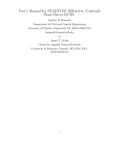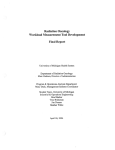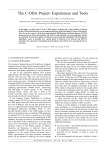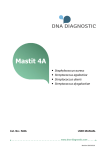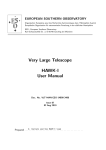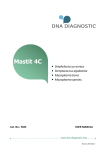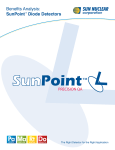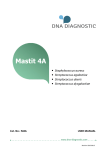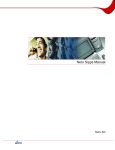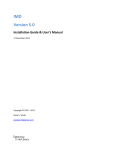Download Here - Laser Pointer Safety
Transcript
Sample Discussion for ANSI Z136.6 GUIDANCE FOR NEW “AVIATION SAFETY LABEL” ON HANDHELD CLASS 3 AND CLASS 4 LASERS EMITTING VISIBLE LIGHT ANSI currently makes recommendations for warning labels on equipment which may be modified or otherwise remanufactured by end users. In this section, ANSI is giving guidance to to add additional text, or an additional label, to inform users of potential hazards to aviation if the laser is misused. These hazards were unknown at the time the first laser label standards were developed. This new “Aviation Safety Label” is intended for handheld lasers (longest dimension less than or equal to 15 inches) emitting visible light (wavelength greater than 400 nm but less than or equal to 700 nm) of Class 3 or Class 4 power levels (accessible output power of 1mW or greater). RATIONALE Current laser labeling laws are not effective in communicating the potential hazard of laser light visually interfering with aircraft operations. Users need to be more aware of this hazard to prevent misuse. This also improves enforcement efforts, since users cannot claim to be unaware of the consequences of their actions. (For example, prosecution under 18 USC 32(a)(5) and 18 USC 2(39A)(a)requires establishment of willful intent.) GUIDANCE Therefore, operators of lasers used outdoors shall add an “Aviation Safety Label” stating the potential hazard and consequences of aiming visible laser light at aircraft. Such guidance should also be added to the user manual. This requirement applies to handheld lasers (largest dimension less than or equal to 15 inches) emitting visible light (wavelength greater than 400 nm but less than or equal to 700 nm) of Class 3 or Class 4 power levels (accessible output power of 1 mW or greater). There are four exemptions where such lasers are not required to have an Aviation Safety Label. These are based on the size of the laser, and/or on its divergence, diffusion, diffraction or wavelength. The exemptions are defined in a separate section below. Note that even if the Aviation Safety Label is not required, the user manual shall include a Statement of Exemption plus cautionary warnings. THE AVIATION SAFETY LABEL LOCATION The Aviation Safety Label shall be on the outside surface of the laser product, so it is visible to the user under reasonable handling and use conditions. The Aviation Safety Label may optionally be put on external packaging such as a box or presentation case that contains the laser. However, it is not sufficient to put the label only on external packaging; there must be an Aviation Safety Label on the laser product itself. WORDING TO BE INCLUDED ON LABEL AFFIXED TO LASER Some handheld lasers can be quite small. Therefore, the amount of wording on the label can be appropriate to the size of the device. Below are phrases of various lengths. Use the longest version which Patrick Murphy submission to ANSI Z136.6, February 2012! 1 Sample Discussion for ANSI Z136.6 can reasonably fit on the laser at a readable type size (7 pts/0.1” minimum; a larger type size may be used if desired). • DO NOT aim this laser's beam at or near airplanes, helicopters or other vehicles. Visible laser light can startle, flashblind, or injure pilots and drivers. Misuse may result in arrest, fines and/or imprisonment. • DO NOT aim at or near aircraft including helicopters. Visible laser light can startle, flashblind, or injure pilots. Misuse may result in arrest, fines and/or imprisonment. • DO NOT aim at or near aircraft. Laser light can startle, flashblind, or injure pilots. Misuse may result in arrest, fines and/or imprisonment. • DO NOT aim at or near aircraft. Misuse is illegal. • DO NOT aim at or near aircraft. Here is a sample label using the longest version, in the minimum-required 7 point type. This particular example is formatted as a long rectangle which can be put onto the barrel of a pen-sized laser pointer. DO NOT aim this laser's beam at or near airplanes, helicopters or other vehicles. Visible laser light can startle, flashblind, or injure pilots and drivers. Misuse may result in arrest, fines and/or imprisonment. To blend in better with a black barrel, the label can be in reverse type as well: DO NOT aim this laser's beam at or near airplanes, helicopters or other vehicles. Visible laser light can startle, flashblind ,or injure pilots and drivers. Misuse may result in arrest, fines and/or imprisonment. Here is a sample label using the shortest version, also in 7 point type, for a laser pointer that may be extremely small: DO NOT aim at or near aircraft. The aviation caution wording shall NOT be included in the text of other labels, such as the CAUTION/ DANGER warning logotype label. Those labels refer to the eye/skin hazard of the laser and have become familiar over decades of use. The Aviation Safety Label warns of a new hazard, not to the user but to pilots, drivers and others. Therefore, the wording shall appear on its own. (There may be one physical label that includes the warning logotype and the Aviation Safety Label , but these shall be two separate graphics on the one physical label.) [OPTIONALLY: “The aviation caution wording shall be included in the text of the CAUTION or DANGER warning logotype label.” I personally think a new label is better, to get people’s attention.] WORDING VARIATIONS FOR LASERS DELIBERATELY AIMED AT AIRCRAFT Some laser products are intended to be aimed at aircraft. One example is a “Laser Rescue Flare” -- a Class 3R laser sold to the general public for use in signaling search-and-rescue aircraft. Also, FAA, NASA and others have tested lasers for warning pilots (in the Washington Air Defense Identification Zone), or for indicating position on a guide slope. In such cases, the label and user manual wording may be modified as necessary to indicate the appropriate use with aircraft. In the case of the Laser Rescue Flare, suggested wording is: Patrick Murphy submission to ANSI Z136.6, February 2012! 2 Sample Discussion for ANSI Z136.6 • DO NOT aim at or near aircraft, except to make your position known in an emergency situation or when a cooperating aircraft is looking for your signal. It is otherwise illegal to aim at aircraft and distract pilots. Misuse may result in arrest, fines and/or imprisonment. EXEMPTIONS An Aviation Safety Label is required on Class 3 and Class 4 lasers which emit visible light. There are a few exemptions, described below, where the label is not required on such lasers. These exemptions are optional, A manufacturer may choose to affix an Aviation Safety Label even if the laser is or might be exempt. This can be done for convenience (so the manufacturer does not have to determine whether or not a laser is exempt) or simply to increase safety by providing additional information to the user. EXEMPTION FOR LASERS LARGER THAN “HANDHELD” A laser is exempt if its largest dimension (length, width or height) is greater than 15 inches. This is because smaller “handheld” lasers have been disproportionately involved in aircraft illumination incidents. The 15” dimensional limit does not include wires, antennas, key chains, carrying straps or similar flexible and/or small-diameter additions to the main emission device or module. Also, the 15” dimensional limit encompasses the laser-emitting device; it does not include a shell, housing, lens hoods, detachable handles, auxiliary battery packs, separate power supplies or any other parts that can be readily removed so that the laser emission device or module’s greatest dimension becomes less than 15 inches. EXEMPTION FOR LASERS NOT USED OUTDOORS If a laser is of a size or configuration where it is expected never to be used outdoors, an Aviation Safety Label is not required. Keep in mind that lasers originally intended for one purpose can be modified for another. For example, many outdoor laser light shows have used YAG lasers originally sold for medical purposes (e.g., indoors use). Also, it may be possible for a laser’s beam to be aimed out a window or otherwise go into airspace, even if the laser itself cannot move. Therefore, it may be appropriate to have an Aviation Safety Label somewhere on the equipment such that a person buying used equipment could see the label. EXEMPTION FOR HIGH-DIVERGENCE AND DIFFUSE LASERS A laser is exempt if it has a highly diverging or diffuse beam, such that its irradiance is below 5 µW/cm² at all distances beyond 500 feet from the laser source, under all operating conditions. (This corresponds to being below the FAA’s Critical Zone light limit, at the minimum altitude Above Ground Level normally required for aircraft in Federal Aviation Regulations Part 91, Section 119.) EXEMPTION BASED ON VISUAL EQUIVALENCE FORMULA A laser is exempt if its combination of power, wavelength and divergence is below the equivalent of 5 µW/ cm² of 555 nm (green) laser light, at all distances beyond 500 feet from the laser source. This is because the human eye is most sensitive to green light; a laser of a different wavelength (color) may appear less bright and thus may not present a visual interference hazard. If a manufacturer wishes to consider wavelength as a factor for exemption, then measure the laser’s power, wavelength and divergence and use the following Visual Equivalence Formula: 4 × Power × VCF π × (15240 × Divergence)² Patrick Murphy submission to ANSI Z136.6, February 2012! 3 Sample Discussion for ANSI Z136.6 Power is expressed in Watts, the wavelength’s VCF (Visual Correction Factor) is from the table in Appendix 1, and the Divergence is expressed in radians. (The formula and VCF table data are derived from the ANSI Z136.1 standard. The number “15240” in the denominator represents 500 feet expressed in centimeters.) The formula’s result will be in W/cm². If the result is less than 0.000005 W/cm² (5 µW/cm²) under all operating conditions, then the laser is not required to have an Aviation Safety Label. EXEMPTION FOR DIFFRACTED LASERS Lasers using diffraction grating or similar technology to break up a beam into smaller, less powerful beamlets are exempt from the user manual and labeling requirements, if at a distance of 500 feet from the laser source, no individual beamlet is Class 3 or Class 4 (e.g., 1 mW or greater) AND the total power of the ten most powerful beamlets within a circle 1 foot in diameter does not exceed 5 mW. This holds for any configuration of the beamlets. (E.g., if two rotating difraction gratings are used, measure the most powerful beamlet when it is in its most “collapsed” state and therefore at maximum power.) ADDITIONAL NOTE FOR EXEMPTIONS BASED ON DIVERGENCE, DIFFUSION AND DIFFRACTION For lasers which are exempt due to divergence, diffusion or diffraction, the exemption must apply under all operating conditions. For example, if the laser device is focusable, at the tightest focus the beam irradiance must remain below the limit; otherwise, an Aviation Safety Label is required. In addition, the user must not be able to remove the lens or diffusing/diffracting device without causing permanent damage to the housing or permanent loss of original functioning. Patrick Murphy submission to ANSI Z136.6, February 2012! 4 Sample Discussion for ANSI Z136.6 USER MANUAL USER MANUAL STATEMENTS, WHEN A LABEL IS REQUIRED If a Class 3 or Class 4 laser product is required to have an Aviation Safety Label, the following statements shall be included in the user manual. They shall have a prominence equal to that of other laser safety cautions (e.g., eye or skin hazard statements). • DO NOT aim this laser's beam at or near airplanes, helicopters or other vehicles. Visible laser light can startle, flashblind, or injure pilots and drivers. This is a hazard to the safe operation of the aircraft or vehicle. Interference with aircraft is prosecutable under civil and criminal law. Misuse may result in arrest, fines and/or imprisonment. • It is not recommended to modify this laser or its beam, so as to increase or concentrate the light energy beyond its normal, factory-set operational limits. Doing so may cause a greater potential hazard to eye, skin and/or visual task interference. The user manual statements may be modified if necessary, for lasers used in special circumstances. One example is a “Laser Rescue Flare”, used to signal pilots in an emergency situation. Suggested wording is provided elsewhere in this document. USER MANUAL STATEMENTS, WHEN A LASER IS EXEMPT If a Class 3 or Class 4 laser product emits visible light, but is exempt from the Aviation Safety Label requirement (due to the laser’s size, or the beam’s divergence, diffuseness, diffraction or wavelength), a Statement of Exemption shall be included in the product’s user manual. The paragraph shall begin by stating the exemption: • STATEMENT OF EXEMPTION FROM A LABELING REQUIREMENT: This laser emits visible light at a Class 3 or Class 4 level. It is exempt from ANSI Z136 requirements for an Aviation Safety Label, for the following reason[s]: .... The paragraph shall then continue by including the appropriate reason(s) for the exemption: • ... The laser is larger than “handheld” as defined by CDRH (the laser-emitting device’s greatest dimension is larger than 15 inches). • ... The laser beam’s irradiance is below 5 µW/cm² at any distance greater than 500 feet from the laser source, under all operating conditions. • ... The laser beam is diffracted so that at a distance of 500 feet from the laser source, no individual beamlet is Class 3 or Class 4 (e.g., 1 mW or greater) AND the total power of the ten most powerful beamlets within a circle 1 foot in diameter does not exceed 5 mW, under all operating conditions. • ... The laser beam’s irradiance has been calculated, using CDRH’s Visual Equivalence Formula, to be below the equivalent of 5 µW/cm² of 555nm green light at any distance greater than 500 feet from the laser source, under all operating conditions. In addition, the following two paragraphs shall appear in the user manual: • It is not recommended to modify this laser or its beam, so as to increase or concentrate the light energy beyond its normal, factory-set operational limits. Doing so may cause a greater potential hazard to eye, skin and/or visual task interference. Patrick Murphy submission to ANSI Z136.6, February 2012! 5 Sample Discussion for ANSI Z136.6 • Although this laser is exempt from having an Aviation Safety Label, it is good practice to never aim a laser’s beam at or near an airplane, helicopter or other vehicle. Visible laser light can startle, flashblind, or injure pilots and drivers. Misuse may result in arrest, fines and/or imprisonment. The wording of the previous paragraph may be modified appropriately if the product is intended for use with aircraft or vehicles; for example, a “Laser Rescue Flare” discussed elsewhere in this document. Patrick Murphy submission to ANSI Z136.6, February 2012! 6 Sample Discussion for ANSI Z136.6 APPENDIX 1 Wavelength / Visual Correction Factor Table Laser wavelength (nm) Visual Correction Factor (VCF) Laser wavelength (nm) Visual Correction Factor (VCF) 400 0.0004 555 1.0 410 0.0012 560 0.9901 420 0.0040 570 0.9524 430 0.0116 580 0.8696 440 0.0230 590 0.7576 450 0.0380 600 0.6329 460 0.0599 610 0.5025 470 0.0909 620 0.3817 480 0.1391 630 0.2653 490 0.2079 640 0.1751 500 0.3226 650 0.1070 510 0.5025 660 0.0061 520 0.7092 670 0.0321 530 0.8621 680 0.0170 540 0.9524 690 0.0082 550 0.9901 700 0.0041 The table data is taken from FAA Advisory Circular 70-1, Table 5, Visual Correction Factor for Visible Lasers. The FAA’s table, in turn, is derived from ANSI Z136.1. If the laser’s wavelength falls between two table entries, use the more conservative (larger) VCF. If the laser’s wavelength can be varied, use the wavelength giving the most conservative (largest) VCF. If the laser emits more than one wavelength simultaneously, measure the power of each wavelength separately. For each wavelength, use the Visual Equivalence Formula to calculate that wavelength’s equivalent power in W/cm². Sum all the results to find the total equivalent power, for all wavelengths simultaneously. Patrick Murphy submission to ANSI Z136.6, February 2012! 7







